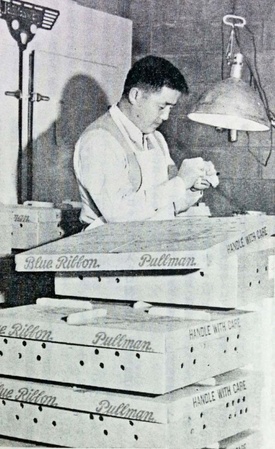The three central north states are Minnesota, South Dakota, and North Dakota. In the Centennial History, ten pages are devoted to the area in Chapter 16.
Minnesota
"Before the Chicago World's Fair in 1893, there was a department store run by Tanaka Kusutaro called "Kiritsu Kogyo Kaisha" and a Japanese store called "Kansai Boekisho" in St. Paul, and Matsubara Shigehide and others were in charge of business there, so it's a story from quite some time ago," he said, referring to the Japanese pioneers in the state.
Kitagawa Tometaro, who made a name for himself dealing in Japanese paintings and other fine art, and Dr. Ikeda Kanae, known even in the US as an authority on pathology and who taught at the University of Minnesota, were other Japanese Americans who were active before the war, including Yamazaki Yoshinosuke, who was from Fukui Prefecture and ran a tea shop off the battleship Stewart, and Akamatsu Jiro, who was from Hiroshima Prefecture and ran an Oriental art store.
Some Japanese people came to Minneapolis as international students, some of whom worked in Chinese restaurants, but were fired when relations between Japan and China deteriorated.
Japanese-American soldiers receive training at the Army Language School
Most of the Japanese people were concentrated in the Twin Cities of Minneapolis and St. Paul. The population of Japanese people was 51 in 1900, and then increased slightly, but returned to 51 in 1940 before the war, and then rapidly increased to 1,726 in 1960. The reason why Japanese people settled in the Twin Cities is said as follows.
"They lived peacefully without suffering from racial discrimination. Many of them married white women. The reason why so many Japanese people relocated to the Twin Cities area during and after the war was closely related to the Army Language School that opened during World War II... Because Minnesota proved to have the least racial prejudice in the country, it was decided to set up a school in Savage, a suburb of Minneapolis. The Japanese language school was later moved to Fort Snelling. From 1942 until it closed in 1946, approximately 6,000 Japanese, Korean and Chinese soldiers were educated there, the majority of whom were Japanese."
The people who came to the Twin Cities after the war were mainly from Seattle, San Francisco, Sacramento, and Los Angeles, and many of them were Christians, so various related organizations were born. There was also a Japanese Christian Church, which was a church for only the first generation of Japanese who did not understand English well.
Sexing technology deployed and successful
Two brothers, Taro and Jouji Saeki, are widely known as success stories of Japanese people in Minnesota. Based in Mankato, the two run the International Sexing Association, a contracting business that specializes in sexing chicks, a specialty of the Japanese.
He expanded his business widely, mobilizing cattle appraisers throughout North and South Dakota, Minnesota, Wisconsin, Illinois, and Iowa. His father, Taro Saeki, originally ran a chicken farm in Fresno, California, and established a cattle appraiser school.
North and South Dakota
Japanese people in South and North Dakota are few among the states in the central U.S. A look at the population statistics for Japanese people shows that in 1900 there was one in South Dakota and 148 in North Dakota, in 1910 there were 42 and 59, respectively, in 1920 there were 38 and 72, in 1930 there were 19 and 91, in 1940 there were 19 and 81, in 1950 there were 56 and 61, and in 1960 there were 188 and 127.
Both states have cold climates that are not suitable for agriculture, so it is thought that there were few Japanese settlers in agriculture. On the other hand, the number of Japanese immigrants to North Dakota is greater than in the eastern and southern states, probably because they came to the state at one time as railroad workers, mine workers, and farm workers.
11 people killed in train accident
The main Japanese settlements in North Dakota are in the cities of Wilston and Mynatt, which are key points on the Great Northern Railroad main line, and in the cities of Bismarck and Medina, which are on the Northern Pacific main line. It was here that accidents involving Japanese people occurred.
"According to records, in 1901, a bookman for the Great Northern Railroad named Omura Sadakichi was leading a gang near the border between Montana and North Dakota when, due to an error on the part of the company, a material car collided with the train, resulting in eleven Japanese killed instantly and twenty-four injured. The bodies were soon buried in Wilston Cemetery on the North Dakota side, (omitted) but later, donations were raised to erect a fine stone monument for the eleven dead, to console the souls of these people who had died as pioneers of ethnic development on the northern frontier of the United States."
"Military Brides" Lived in the Postwar Homes
Then, during the war, big changes occurred.
"When war broke out between Japan and the United States at the end of 1941, a wartime internment camp was set up at the Bismarck Barracks, and several hundred Japanese leaders were escorted from the three Pacific coastal states. This was probably the largest number of Japanese in the history of North Dakota, even if only temporarily.
Regarding the rapid increase in population after the war, as seen in the 1960 census, the report states, "The biggest reason is believed to be that a considerable number of military brides from Japan came to live in this remote area."
Japanese people first came to South Dakota in connection with railroad construction, and it is believed that this began around 1914. Some Japanese settled there as farmers, and from around 1916 or 1917, Japanese farmers who had previously lived in Colorado, mainly came to South Dakota, seeing potential in sugar beet cultivation. Overall, the number of Japanese people was small, so there were almost no anti-Japanese issues.
The Centennial History concludes that the reason for the sudden increase in the Japanese population in the state in 1960 was "likely to be the result of a nationwide trend in recent years in which Japanese military brides came to settle in the state."
(Note: I have used the original text as much as possible, but have made some edits. Titles have been omitted.)
*Next time we will introduce " Japanese people in the five central states ."
© 2015 Ryusuke Kawai







